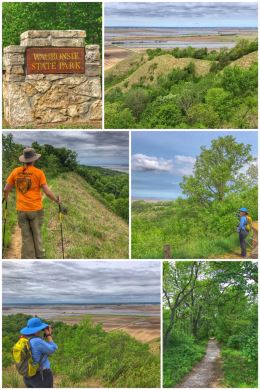
We hit Iowa (state #22 on our travel across the U.S.) almost immediately after leaving Nebraska City, Nebraska, as we crossed the Missouri River into a sea of flooded fields and farmland. In fact, the roads had just been partially reopened (after repairs from flooding); even the interstate was affected. It is truly incomprehensible how much flooding we have seen this year… it’s been almost nonstop in our travels from Mississippi through Iowa.
We started our adventure in Iowa at Waubonsie State Park, just outside Hamburg, which offers amazing views of the Missouri River Valley, and which was still mostly flooded. We chatted with a local who said a few weeks back, almost the entire valley was flooded as several levees had breached sending even more water streaming into the farmlands.
The 2,058-acre state park is located in the Loess Hills region of Iowa and named for Chief Wabaunsee of Potawatomi tribe. The Loess Hills are a unique formation, sitting on the eastern edge of the Missouri floodplain in western Iowa (as well as parts of Missouri, Nebraska, and Kansas) — and consists of an extraordinary landscape of prairie and forest covered steep bluffs, narrow ridges, and rolling hills. What makes these formations unique is that they are entirely created by windblown soils. Toward the end of the last ice age, over thousands of years, winds picked up soils that had been ground as fine as flour by ancient glaciers (loess) and formed dunes of heights greater than 200 feet along the ancient waterway that became today’s Missouri River. Later, erosion of the loess soil helped shape the landscape; even later, topsoil formed on the loess and plants and trees began growing on the hills. Although deposits of loess are found across the world, nowhere else but in China are those deposits higher than they are in Iowa.
The park has a number of short, but interesting trails, and we hiked a unique combination of the Waubonsie Overlook Trail (short and easy trail up to an overlook), a bit of the Ridge Trail, but mainly hiked the Sunset Ridge Trail (a loop with another great overlook of the Missouri River Valley)… in total, we hiked about 3.5 miles. Other trails include the Bridge and Valley trails. Besides the trails, the park offers picnic areas, cabins, regular and equestrian campgrounds, and boating and fishing on Lake Virginia.
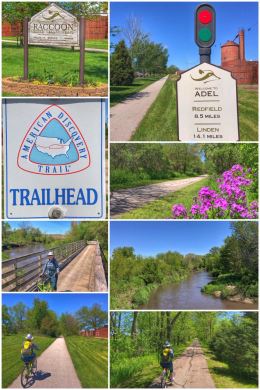
From there, we headed to Adel, just outside of Des Moines, passing miles and miles of cornfields. (Iowa is the top producer of corn in the U.S., and ranks among the leaders in growing soybeans. Other major crops include oats and hay, red clover, flaxseed, rye and wheat.)
When we arrived, we ran into more rain and storms, but also found time for some fun… starting with a 15-mile bike ride on the Raccoon River Valley Trail, which runs 89 miles from Clive to Jefferson… passing through woodlands, prairie, and farm landscapes. We jumped on at Brickyard Park, just west of Adel (off of Greene Street), biking westward to Redfield. The trail bed is smooth (concrete/asphalt) and the main trail follows a former railroad right-of-way that was first built in the 1870s to carry rail traffic between Des Moines and the Great Lakes region. (The trail actually contains a newer loop that was also a rail corridor; the main trail is on the old Milwaukee Road corridor and the new segment on the former rail bed of the Minneapolis & St. Louis Railway.)
The portion of the trail we biked is also part of the American Discovery Trail, a multi-use (non-motorized) trail that runs east to west, from Cape Henlopen State Park in Delaware to Point Reyes in Northern California. (We also biked part of the trail when we were in Kansas.) Learn more here: American Discovery Trail. The Raccoon River Valley Trail charges a $2 per person per day fee, but it’s up to users whether they actually pay the fee.
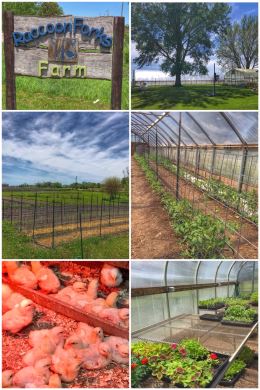
Next up after the bike ride was a short drive to Raccoon Forks Farm, which we found on EatWild.com. The farm grows locally grown, chemical-free food by practicing sustainable farming and animal husbandry at two farm sites in Redfield and
Runnells.
The farm offers eggs, broiler chickens and stewing hens, goat and mutton meat cuts, a wide variety of vegetables, a small but growing variety of fruits, Great Pyrenees puppies, handmade soaps, and decorative and household items made from reclaimed wood.
We had a wonderful tour of the facilities, including the two greenhouses (where veggies are grown from seeds), several barns (including one where baby broiler chicks were staying warm and cozy under a heat-light while they mature, pastures where chickens roam freely, and the gardens.
Another cool aspect of the farm is that they provide job opportunities to individuals with disabilities and other barriers to employment. Disabled employees at the farm receive one-on-one job coaching and the support they need to build skills and be successful on the job.
We left with two dozen eggs, a broiler chicken (which we intend to cut up and grill), and a goat boneless loin (which we also intend to grill).
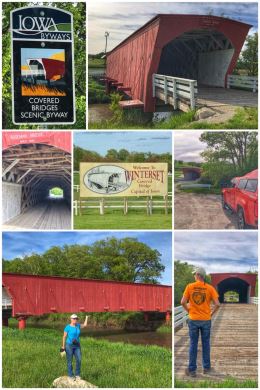
Next up was a visit to the infamous covered bridges of Madison County. The county is the Covered Bridge Capital of Iowa, with the largest group of covered bridges that exists in one area in the western half of the Mississippi Valley. After looking at a map of the bridges, we decided to focus on visiting two of the originals. (Sadly, Cedar Bridge had to be rebuilt after arsonists torched the original.)
During the 1870s, Madison County contracted for a series of timber trussed bridges covered with roofs and walls. The covered bridges were constructed to protect the roadway from harsh weather because the heavy beams of the bridge were much more expensive to repair or replace than the roof and walls. Experts estimate about a hundred of these types of covered bridges were constructed in Iowa during the mid to late 1800s, but most have been destroyed by flooding, fire, collisions, or simply demolished. In Madison County, 19 covered bridges were constructed; six remain.
We started at Hogback Covered Bridge, located in a valley north of Winterset. The 98-foot long bridge over the North River was built in 1884 by Harvey P. Jones and George K. Foster. The Hogback gets its name from the limestone ridge which forms the west end of the valley.
We then drove southwest of town to perhaps the most famous of the covered bridges (thanks to the Robert James Waller’s novel Bridges of Madison County and the movie by the same name), the Roseman Covered Bridge (also known as the Oak Grover Bridge), built over the Middle River in 1883 — also by Jones and Foster. The bridge is also unique in that it was built with a superimposed “queenpost truss” to add structural redundancy and strength. The bridge is also supposed to be haunted, but the only haunting we saw that day were two women from Florida filming a little video about the bridge and the movie.
If you’re the type that likes crowds and festivals, then plan on visiting in the second full weekend in October when the Madison County Covered Bridge Festival is held. The event provides a wide variety of food, antique and craft vendors, music and entertainment, artisan demonstrations, quilt show, car show, antique vehicle parade, and, of course, guided bus tours of Madison County’s covered bridges.
By the way, Winterset is also the birthplace of John Wayne, so not only will you see lots of John Wayne movie posters and memorabilia, but there is also a John Wayne Birthplace and Museum. (Westerns are not really our thing, so we did not stop and visit, but interestingly, we have now encountered John Wayne fervor twice — after first encountering it in Monument Valley, Utah, where many iconic Wayne westerns were filmed.)
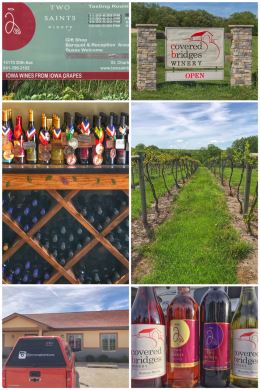
We are more the wine-tasting types, so after visiting the bridges, we mapped out an adventure to two local wineries, starting first with Covered Bridges Winery (located conveniently near the covered bridges, just off Hwy 169, north of Winterset).
The tasting room is fairly new and has beautiful natural light from lots of big windows, making it feel welcoming as you enter. The tasting was fun and we enjoyed a variety of whites and reds — leaving with a bottle each of the Holliwell Bridge (an off-dry white grape blend) and Roseman Bridge (a light, fruity rose made from Chardonnel and Corot Noir grapes).
We ended the day at Two Saints Winery, located in St. Charles (about 15 miles east of Winterset; about 21 miles south of West Des Moines). The family-owned winery is one of the few in Iowa that specializes in wines from grapes grown not only in Iowa, but in Warren County — and most from their estate vineyard. We enjoyed a pleasant tasting, discussing the rains, storms, and flooding while sipping some very nice wines. We left with a bottle each of Trinity Red (a semi-sweet red with a fruity bouquet of dark berries that finishes with light cherry and citrus notes and has a name dear to our hearts) and Noiret (a fruit-forward dry red wine with a peppery finish that reminded us of a zinfandel).
Iowa is heavily promoting wineries and craft brewers across the state. The Iowa Wine & Beer Promotion Board even has an app to help you find them. Currently, the state is home to 100 commercial wineries and more than 300 vineyards, covering more than 1,200 acres.
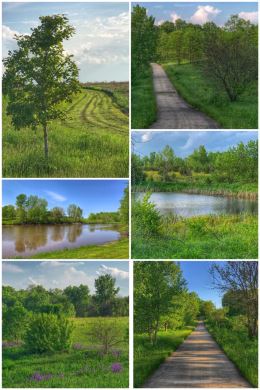
We sadly left Adel and the Des Moines area (which has a Whole Foods and a Natural Grocers, among other great things) and headed to Mount Pleasant, a beautiful and very pleasant town in southeastern Iowa. Our main goal with this stop was to visit an old friend who lives in Fort Madison, about 34 miles further southeast, but as always, we found fun and adventure right where we camped.
The highlight for us in Mount Pleasant was East Lake Park (located only a mile from our campground), which connects to the Mount Pleasant Recreation Trail, a beautifully designed and produced concrete trail that connects several parks and ball fields in the town — and as you can see from the pictures, is lush and green and scenic. We hiked various parts of the trail several times while staying the Crossroads RV Park.
Again, for those who like festivals and crowds, consider visiting Mount Pleasant some Labor Day weekend, when the town celebrates the agricultural heritage of the Midwest with live-action displays and exhibits of restored mechanical equipment (including tractors, steam engines, and more), as well as country music and other entertainment and lots of food. The event is the Midwest Old Thresher’s Reunion, which often draws crowds of more than 100,000 over a five-day period in Septembers. (A thresher is a person or machine that separates the grains/seeds from the plant by beating the plant until the seeds fall out.)
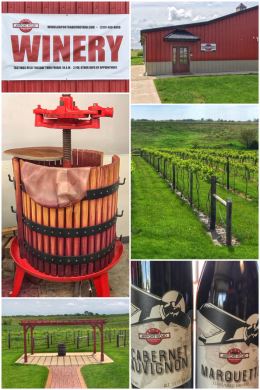
The other very pleasant surprise for us in Mount Pleasant was Airport Road Vineyard & Winery, located just southeast of town Lexington Avenue… and just a few miles from the campground. Their tasting room is typically open between 10 am and 3 pm Tuesday-Friday, but they recommend calling or emailing before heading over.
Dave Rogers, whose family owns the winery, was an amazingly gracious host as we tasted a variety of their wines. (Amusingly, Dave and his wife once worked for Disney in Orlando, Florida, not far from where Ran worked at Stetson University.) The winery has hundreds of vines planted and the owners are considering future options on their property.
The tasting room is part of a larger building that includes a beautiful banquet room used throughout the year for weddings and meetings.
The winery is a gem, and we quite enjoyed the variety of wines we tasted, as well as seeing the operations and discussing future wine offerings.
We left with a bottle of their Cabernet Sauvignon (with grapes brought in from California), a medium body, tasty red; and, a bottle of their Marquette (from grapes grown in their vineyard), a fruit-forward, soft red.
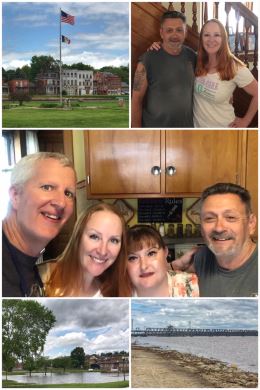
Our main goal was accomplished when we traveled down to Fort Madison to visit with old friend Ed Bruner. Ed grew up in Fort Madison, but lived in the San Diego area for many years after he completed his time in the Marines… moving back home a number of years ago. He served as a great tour guide, pointing out all the highlights of the town, including a section of beautiful historic homes. We later also got to spend time with his significant other, Pam.
Fort Madison sits right on the Mississippi River (which was definitely showing signs of being higher than average, flooding nearby parking lots), and was the location of the first U.S. fortification along the upper Mississippi River. The fort was named in honor of the President James Madison. The town grew up around the fort… and later the railroad. It is home to several major industries/employers (including SIEMENS, Scotts Miracle-Gro, Pinnacle Foods Group, Bagcraft Papercon, and DuPont), as well as the maximum-security state prison. It is also home to the world longest and last remaining double swing-span bridge on the Mississippi River — with a top level for cars and a lower level for trains.
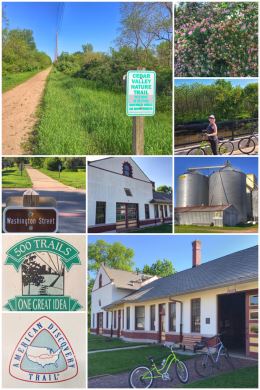
After we left Ed and Pam, we traveled up to our last stop in Iowa, driving up to a campground in Urbana called Lazy Acres, located about halfway between Cedar Rapids and Waterloo.
Our adventures here started with a bike ride on the Cedar Valley Nature Trail, which passes through Urbana, about a mile from the campground. The 67-mile rail-trail runs from Cedar Rapids to Waterloo, traveling through wetlands, forestland, and farmland. We biked 15 miles, from Urbana to Center Point, using the old depot as a resting point before turning around. The depot has restrooms and benches, as well as a museum that is open on Sundays in the summer.
The trail follows the former right-of-way of the Waterloo, Cedar Falls & Northern Railway (known as the Cedar Valley Road) — which ran both electric passenger trains and freight on the line. The surface varies along different stretches of the trail, from concrete/asphalt in the north and south sections to crushed stone in the middle section.
The rail-trail was one of the first conversions in the state — and one of the first 500 in the country. There are now more than 2,000 rail-trails across the U.S., with another 800 under development!
Even more amazingly, we discovered we were once again — now for the third time — on a section of the American Discovery Trail, a 6,800-mile multi-use (but non-motorized) trail that crosses the country. Another amazing discovery is that the state has a trails council, an all-volunteer staff whose mission is to continue developing trails in Iowa.
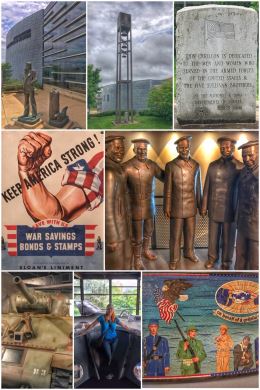
On Memorial Day, we decided to honor those men and women who paid the ultimate price when they died defending the ideals of the United States by driving up to Waterloo and visiting the Sullivan Brothers Iowa Veterans Museum.
The museum is named in honor of the five — yes, five — brothers who enlisted in the U.S. Navy to fight together in our country’s war against Japan in World War II… and who all died while serving on the USS Juneau when torpedoes quickly sank it off the Solomon Islands. In total, 687 men were killed as a result of that attack; four brothers went down with the ship, while one survived for a short time on a lifeboat (along with about 100 others), but because of various missteps and miscommunications, rescue operations took about a week to reach the survivors — which by then numbered only 10 in two lifeboats.
The museum offers an amazing history of all the wars and police actions and interventions — from the Civil War to our involvement in Iraq and Afghanistan. It includes movies, first-hand accounts and stories, and many exhibits and memorabilia — including an airplane suspended in the lobby to a Huey Chopper and a combat tank.
The Veterans Museum is part of the Grout Museum District, which also includes the Grout Museum of History & Science, Bluedorn Science Imaginarium, Rensselaer Russell House Museum, and Snowden House.
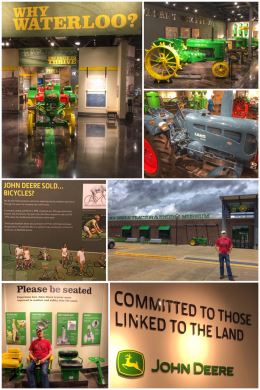
While in Waterloo, we also had to satisfy Ran’s love of tractors by visiting the John Deere Tractor & Engine Museum, housed in a building constructed in 1941 and used in production before being converted to a museum. The goal is to educate visitors about the history of tractor and engine design and manufacturing. The cost is free — and if you plan ahead, you can even schedule a factory tour. (Currently
there are multiple John Deere facilities in Waterloo, including: Drivetrain Operations; Tractor, Cab, and Assembly Operations; Product Engineering Center, Service Parts Operations; Foundry; and Engine Works.)
We, of course, started with the movie, which was short, but thorough. We learned that John Deere was a blacksmith who created the first commercially successful self-scouring plow in 1837… and from that, the company was born, based in Moline, Illinois — and John Deere stayed at the helm of the company for almost 50 years, from 1837 to 1886.
From a marketing perspective, we loved learning that the leaping deer trademark — one of the world’s most recognized corporate logos — has been on the company’s products for more than 135 years. Today, it is the longest continuously used corporate logo of any Fortune 500 company.
The museum is definitely a fun stop for anyone who has an interest in manufacturing, tractors, and history.
Next up, we head into Minnesota for the first time — and work our way (finally) to another national park!
